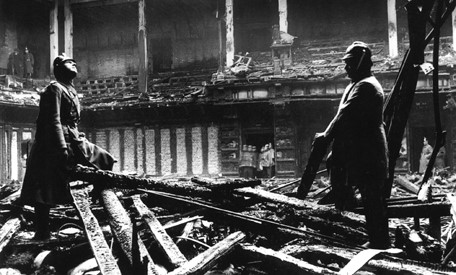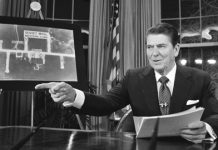On February 27, 1933, the Reichstag building in Berlin was burned down by a Dutch communist, possibly with the assistance of Nazi officials. The arson created a climate of fear that helped Adolf Hitler consolidate power.
Hitler Granted Dictatorial Powers After Reichstag Fire
Berlin’s Reichstag building, the home of the German parliament, was set ablaze on the night February 27. The fire “burned so fiercely that within an hour the main hall…was completely destroyed,” wrote The Guardian. “Flames leaping from the great glass dome surmounting the building could be seen for miles around, and attracted huge crowds to the scene.”
After the fire was put out, authorities discovered a shirtless man inside the building: Marinus van der Lubbe, a mentally unstable 24-year-old Dutch communist. Van der Lubbe admitted to starting the fire as a protest against capitalism.
Nazi Party leader Adolf Hitler, who had been appointed chancellor less than a month earlier, recognized that the incident, which occurred just a week before the March 5 parliamentary elections, could be exploited in his aim to consolidate power. He told a reporter at the scene, “This is a God-given signal! If this fire, as I believe, turns out to be the handiwork of Communists, then there is nothing that shall stop us now crushing out this murder pest with an iron fist.”
The Nazi leadership—Hitler, Hermann Goering and Joseph Goebbels—portrayed the fire as part of a communist plot to take over the government. The day after the fire Hitler convinced German President Paul von Hindenburg to sign an emergency decree “for the Protection of the People and the State,” which became known as the Reichstag Fire Decree.
The decree stripped citizens of their constitutional liberties, including free speech, rights to assembly and freedom of the press. It allowed Nazi government to arrest thousands of leaders from the Communist and Social Democratic parties and shut down their publications and meetings.
Despite the crackdown on their opposition and the widespread voter intimidation by gangs of storm troopers, the Nazis were unable to secure a majority in the election. However, they were able to form a coalition with more moderate right-wing groups and on March 23 pass the Enabling Act. It stripped the Reichstag of its legislative powers and created the legal basis for Hitler’s dictatorship.
Sources in this Story
- The Guardian: Big fire at Reichstag
- The History Place: The Rise of Hitler—The Reichstag Burns
- EyeWitness to History: The Reichstag Fire, 1933
- German Historical Institute: German History in Documents and Images: Building the Nazi Regime
- Time: Germany: Head Into Basket
- Deutsche Welle: 75 Years Ago, Reichstag Fire Sped Hitler’s Power Grab
- The Daily Telegraph: Historians find ‘proof’ that Nazis burnt Reichstag
- Monthly Review: The Reichstag Fire Trial, 1933–2008
- The Guardian: 75 years on, executed Reichstag arsonist finally wins pardon
Analysis: Who Was Responsible for the Fire?
Van der Lubbe was put on trial in September 1933 alongside four communists accused of aiding him: German Ernst Torgler and Bulgarians Georgi Dimitrov, Vasil Tanev and Blagoi Popov. Hitler arranged for the laws on arson, which allowed for a maximum sentence of life in prison, to be retroactively changed to allow for the death penalty.
The trial, according to the German Historical Institute, was a “failure for the Nazi leadership,” as it could not prove that van der Lubbe had any communist conspirators; Torgler, Dimitrov, Tanev and Popov were acquitted on all charges. Van der Lubbe, who testified that he acted alone, was found guilty of treason and arson and sentenced to death. He was executed by guillotine on January 10, 1934.
Historians are divided on the issue of whether Van der Lubbe acted alone. Many believe that he was assisted by Nazi Party members, who wanted to create the illusion of a communist plot.
The Guardian reported the day after the fire: “The wildest rumours were circulating in Berlin last night…One was to the effect that secret orders had been issued to the Nazi Storm Troopers to create a Bartholomew night on Saturday, when all political opponents of renown were to be ‘disposed of.’ Although the police asserted the Communists are responsible, some people think that the fire might have been started by irresponsible Nazis with the object of provoking trouble.”
One prominent theory, explained by The History Place, is that Goering and SA leader Karl Ernst had “befriended the arsonist and may have known or even encouraged him to burn the Reichstag that night.” SA storm troopers, using a tunnel that connected the Reichstag and the presidential palace, prepared the Reichstag for arson by spreading gasoline through the building.
In the early 1960s, German magazine Der Spiegel published a multi-part investigation led by Fritz Tobias that concluded van der Lubbe acted alone. Tobias’ findings, which were published in the book “The Reichstag Fire” in 1962, serve as the basis for the theory that van der Lubbe had no help, which is supported by historians Hans Mommsen, author of “The Reichstag Fire and Its Political Consequences,” and Ian Kershaw, author of “Hitler 1889-1936: Hubris.”
“The Reichstag fire was set by the Dutchman van der Lubbe and he was the sole perpetrator,” Mommsen said in 2008. “The communists did not have anything to do with it and neither did the National Socialists. There are no motives or reasons to doubt he was alone.”
A 2001 article in German history journal Historische Zeitschrif challenged Tobias’ theory based on statements made by storm trooper Adolf Rall to prosecutors in 1933. Rall spoke of being ordered by Ernst enter the Reichstag through the tunnel and dousing the building with flammable liquids. Both Tobias and Der Spiegel released statements defending their original findings.
Historian Alexander Bahar and physicist Wilfried Kugel, authors of the 2001 publication “The Reichstag Fire—How History is Created,” argue that van der Lubbe could not have physically started the fire of such magnitude in such a short time without assistance.
Reviewing the book in socialist magazine Monthly Review, Michael E. Tigar and John Mage write: “Their extensive discussion of the forensic evidence ends the matter; in the eleven to fourteen minutes that van der Lubbe had available according to the testimony at trial, it was impossible for him to have been to all—or even many of—the places where fires were set. Nor could van der Lubbe have carried from place to place the amount of accelerant used to set the fires. Henceforward anyone de-fending the Tobias thesis needs either reject the entire forensic testimony at trial or the laws of nature, or both.”
Van der Lubbe’s guilty verdict was overturned by German prosecutors in 2008. The decision was based on a 1998 law allowing pardons for those convicted by the Nazi regime because Nazi law “went against the basic ideas of justice.” The pardon was unrelated to the question of who was responsible for the fire.
The Rise of Hitler
Historical Context: Hitler and Nazi Germany
The German Historical Institute explains the history of Nazi Germany with links to dozens of primary documents.
The History Place provides a biography of Hitler, tracing his rise and fall.
The findingDulcinea Web Guide to World War II links to the most comprehensive and reliable sources on the war.











